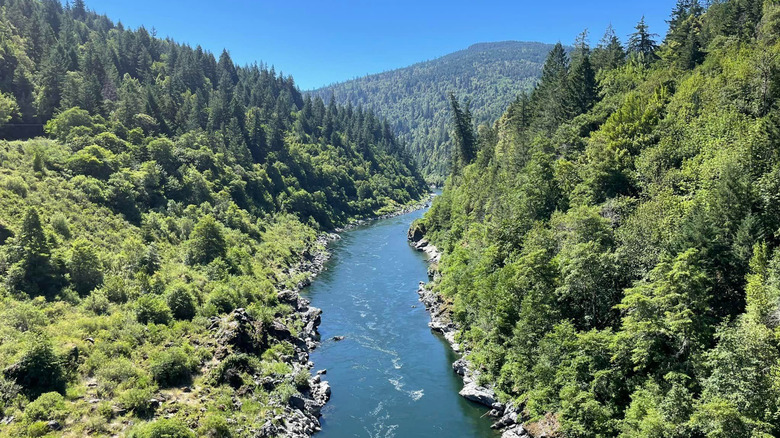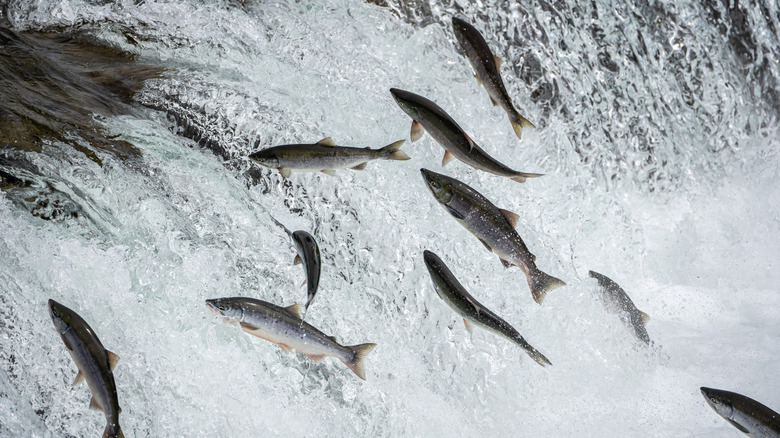One Year After The Klamath Dam Project, Scientists Are Thrilled By Nature's Comeback
October 2025 marks the one-year anniversary of the full removal of the dams on the Klamath River watershed. This is the biggest dam removal project in the world to date, taking down four dams in California and Oregon. Some of the dams had been in place for over a century, causing a multitude of problems on tribal lands. Now, the Klamath River watershed can begin healing.
The problem with the Klamath dams was that they were harming the local environment. The watershed was a hotbed for fish diseases, severely impacting the fish population. Every summer, toxic algae — like the kind stinking up Florida beaches — would bloom, causing danger for fishermen that used that river. It also caused the population level of the Klamath's Chinook — a type of salmon — to be nearly wiped out.
Despite the dam removals, there is still a long road to recovery for this fish population but scientists are happy about the results so far. Salmon are breeding in the upper river once again. Over 400 miles of habitat is being revitalized, with greenery, free-flowing water, and fish turning it back into a paradise. There has been a huge drop in toxic algae. And kayakers are returning to the river, able to adventure the entire length for the first time in a century. The road to get to this point was long and difficult, but this success has made the struggle worth it.
The effort to get the Klamath dams removed
Big dams have often been a source of controversy, like the one in China that literally slowed down Earth's rotation. The Klamath dams were no different. The efforts to get the dams removed began over 20 years ago, mostly in response to the declining salmon population the Klamath River tribal communities depend on. The biggest incident was the 2002 Klamath River fish kill, where over 65,000 salmon were found floating dead in the river. Despite warnings from local tribes and the legal professionals speaking on their behalf, the Bureau of Reclamation redirected water flows from the river for irrigation purposes. The result was water levels too low for breeding salmon to survive.
That fish kill created a domino effect of problems, including a lost generation of salmon. It was a devastating blow to local fishermen who depended on the fish, not just for their own families, but also for commercial purposes. The Bring the Salmon Home campaign began in response, spawning a series of protests and lawsuits. Finally, the agreement to remove the dam was settled in 2016 between the tribes, the states of California and Oregon, and the company that owned the dam, PacifiCorp. The Federal Energy Regulatory Commission had to give its final approval, which came in 2022, and the removal finally began in 2023, finishing in October of 2024.
The effects of the Klamath dam removals
The removal of the hydroelectric dams has seen nothing but a positive impact. Fish have returned to the river, arriving earlier in the year than they used to and traveling further through the river system. This is in part because the dams had increased the heat of the water. With the dam removals, the water temperature lowered, aligning more with the natural seasonal migration of the salmon.
Over 7,000 Chinook salmon swam upriver after the removal of the dams, returning to a territory the salmon haven't been able to access since their construction. Scientists have been closely monitoring all the positive impacts the Klamath dam removals have had. Continuing to monitor them into the future is vital for similar projects. However, this monitoring has hit a snag.
As part of federal funding cuts — which have also impacted space science — the Department of the Interior ended funding from the U.S. Fish and Wildlife Service to CalTrout. CalTrout is a non-profit with a mission to protect the ecosystem and restore damaged areas. This loss of funding is an obstacle in scientific data collection and monitoring of the Klamath River watershed. For now, CalTrout is relying on fundraising so they can continue to understand the benefits these dam removals continue to have.


